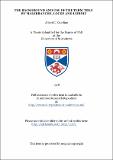Files in this item
The background and use of the term 'idea' by Malebranche, Locke and Leibniz
Item metadata
| dc.contributor.author | Esterline, Albert Crawford | |
| dc.coverage.spatial | iv, 456 p., cli, xxxiii | en_US |
| dc.date.accessioned | 2018-06-27T15:38:15Z | |
| dc.date.available | 2018-06-27T15:38:15Z | |
| dc.date.issued | 1978 | |
| dc.identifier.uri | https://hdl.handle.net/10023/14672 | |
| dc.description.abstract | The general distinction between uses of the term "idea" which we draw is between occurrences in the mind and dispositions for them as opposed to concepts. Locke uses "idea" in the first way, Malebranche uses it in the second. Leibniz allows that the mind is infinite and that dispositions in the body correspond to dispositions in the mind; thus he is able to maintain that idea are both concepts and dispositions in the mind. We explain concepts in terms of conventional rules, for the most part linguistic and especially mathematical. We call a system of conventional rules an objective structure and, as those who took ideas to be concepts held that they are concepts of divine science, we treat God as the unique objective structure. The question in seventeenth century theories of ideas is how that body of knowledge comprising ideas and their relations is applicable to thing. In the first four chapters, we consider concepts and the Cartesian programme to reduce the description of everything but that which applies concepts to mathematical descriptions. Descartes, Malebranche, and Leibniz held that the lack of simplicity and exactness in human knowledge arises from the correspondence between microscopic activities in the body and mental occurrences. With occurrences in the body explained mechanically, it was held, the world can be described with maximum simplicity and exactness. Extended things are law-obeying configurations to which concepts are applied; thinking things are rule-following things by virtue of applying these concepts. But the parts played by convention and behaviour are left out of their accounts and, omitting these, the world cannot be shown to be anything more than a diagram, perhaps portrayed only in the mind of the investigator. In the antepenultimate chapter, we discuss two related views which led the rationalists to maintain that all rational beings naturally follow a unique objective structure: their position on the correspondence between the activity of the body and occurrences in the mind (illustrated in their theories of vision) and the view that divine science is the standard for all scientific formulations. In the penultimate chapter, we present evidence that rationalist accounts of cognition were in fact modelled on rule-governed activity, Plato's theory of knowledge and Ideas is compared with rationalist accounts and is found to have less relevance to rule-governed activity, Kant, we admit, saw the relevance of rules, but no more than the rationalists. In the ninth chapter, we discuss Malebranche's vision in God (which most clearly presents ideas as concepts), its relation to Descartes' and Leibniz's positions and its dependent on occasionalism. In the fifth chapter, we argue against Chomsky's innatist position and, more generally, claims in the behavioural and social sciences to explain human knowledge in terms of internalized components and covert activities. It is also maintained that Chomsky's innatism bears little resemblance to that of seventeenth century rationalism. We discuss in the sixth through the eighth chapters the Scholastic back-ground to the use of the term "idea" and theories of ideas. In the sixth chapter, the pervasive influence of Suarez is established, as is the prevalence of nominalism in the seventeenth century and its connection with Gaszendism and eventually Locke. Suarez combined aspects of Thomism and nominalism, Thomism was concerned with so-called spiritual objects of knowledge, which roughly act as standards and are the contribution of the knower to what is known; rationalism's account of knowledge maintained these aspects of Thomism, nominalism, on the other hand, presented what we shall call a causal or genetic account of knowledge (according to which our knowledge arises from causal relations and operations of the intellect) and was concerned with so-called material objects got from sensation (while allowing for spiritual operations). The distinction between spiritual and material objects and faculties is introduced in the sixth chapter. In the seventh chapter, we discuss the bridge between these facilities, the intellectus agens, which served as an objective structure in Thomist accounts. In the eight chapter, we discuss uses of “spiritual”, “idea” and “mind”, beginning with Scholastic uses, but concentrating on the differences between Descartes and Gassendi. Locke’s causal account is discussed in the final chapter. We emphasise his divergence from Cartesianism, such as his view on the narrow compass of the understanding, his treatment of mathematical ideas as signs and his reliance on mental dispositions. Locke’s position suffers from the omission of concepts. | en_US |
| dc.language.iso | en | en_US |
| dc.publisher | University of St Andrews | |
| dc.subject.lcc | B823.E8 | en |
| dc.subject.lcsh | Idea (Philosophy)--History | en |
| dc.subject.lcsh | Malebranche, Nicolas, 1638-1715 | en |
| dc.subject.lcsh | Locke, John, 1632-1704 | en |
| dc.subject.lcsh | Leibniz, Gottfried Wilhelm, Freiherr von, 1646-1716 | en |
| dc.title | The background and use of the term 'idea' by Malebranche, Locke and Leibniz | en_US |
| dc.type | Thesis | en_US |
| dc.type.qualificationlevel | Doctoral | en_US |
| dc.type.qualificationname | PhD Doctor of Philosophy | en_US |
| dc.publisher.institution | The University of St Andrews | en_US |
This item appears in the following Collection(s)
Items in the St Andrews Research Repository are protected by copyright, with all rights reserved, unless otherwise indicated.

